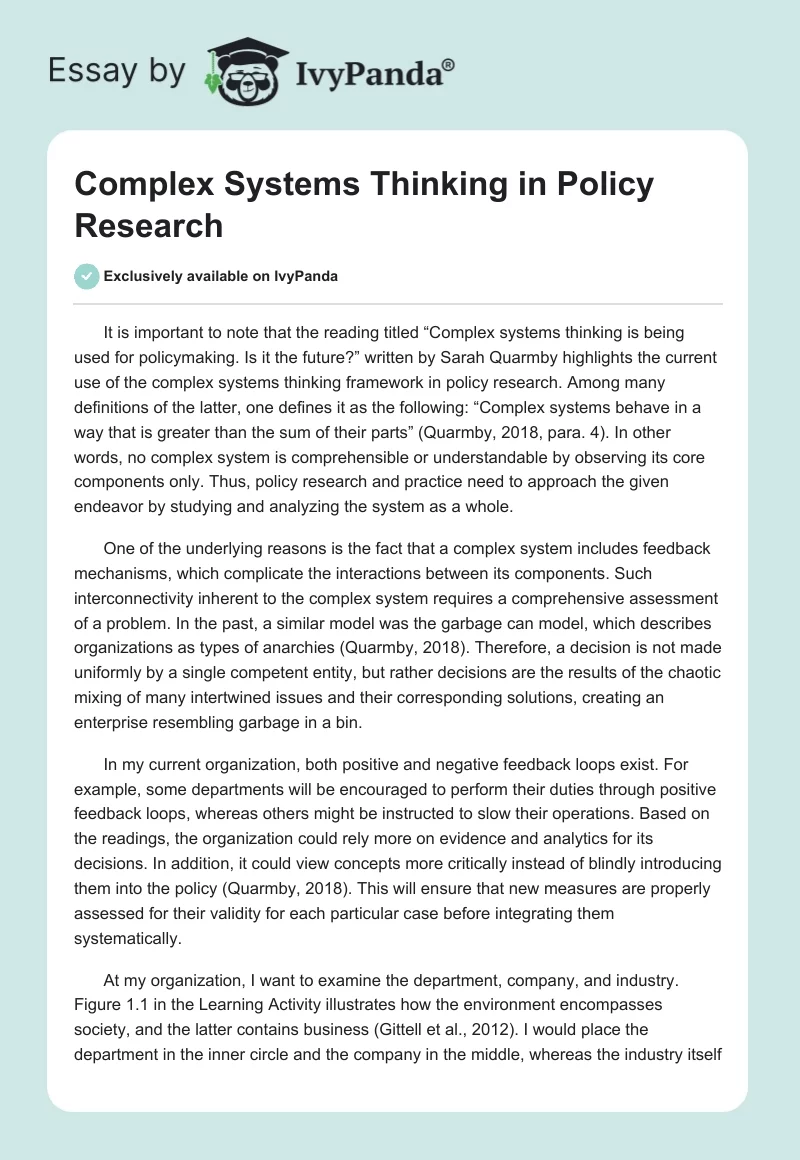It is important to note that the reading titled “Complex systems thinking is being used for policymaking. Is it the future?” written by Sarah Quarmby highlights the current use of the complex systems thinking framework in policy research. Among many definitions of the latter, one defines it as the following: “Complex systems behave in a way that is greater than the sum of their parts” (Quarmby, 2018, para. 4). In other words, no complex system is comprehensible or understandable by observing its core components only. Thus, policy research and practice need to approach the given endeavor by studying and analyzing the system as a whole.
One of the underlying reasons is the fact that a complex system includes feedback mechanisms, which complicate the interactions between its components. Such interconnectivity inherent to the complex system requires a comprehensive assessment of a problem. In the past, a similar model was the garbage can model, which describes organizations as types of anarchies (Quarmby, 2018). Therefore, a decision is not made uniformly by a single competent entity, but rather decisions are the results of the chaotic mixing of many intertwined issues and their corresponding solutions, creating an enterprise resembling garbage in a bin.
In my current organization, both positive and negative feedback loops exist. For example, some departments will be encouraged to perform their duties through positive feedback loops, whereas others might be instructed to slow their operations. Based on the readings, the organization could rely more on evidence and analytics for its decisions. In addition, it could view concepts more critically instead of blindly introducing them into the policy (Quarmby, 2018). This will ensure that new measures are properly assessed for their validity for each particular case before integrating them systematically.
At my organization, I want to examine the department, company, and industry. Figure 1.1 in the Learning Activity illustrates how the environment encompasses society, and the latter contains business (Gittell et al., 2012). I would place the department in the inner circle and the company in the middle, whereas the industry itself would be placed in the outer circle. The proposed model is made in this manner primarily because each smaller element is part of a larger whole. These particular choices were made because departments tend to operate with a degree of autonomy depending on the organizational design. Each department follows a strict set of its procedures to meet its quarterly or yearly goals in performance. For example, a sales department wants to increase sales, whereas an HR department wants to retain the existing talent and attract new ones as well.
However, departments can become excessively focused on their performances, issues, and achievements that a larger and more important vision can be lost in regards to the company itself. Most companies and businesses operate as a cohesive whole competing in a particular industry. A company seeks to gain a competitive advantage and a larger market share to dominate over its rivals. Businesses devise business models, marketing plans, long-term goals, and strategic positioning to gain more competitiveness in the market. Thus, even at a company level, businesses and their leaders should not forget that they are mostly operating in a larger industry. One should note that industries and their corresponding markets are vulnerable, such as coal mines declining in the face of green energy and climate concerns, as well as the oil and gas industry.
It is important to note that integrated social systems understand and view major problems as a complex whole rather than a separate case. It is applied by accounting for the consequences and implications of one’s actions in the larger environment in which one operates. The core steps include topic identification, boundaries and environment, society or people, economics, conceptual framework, challenges, and solutions (Gittell et al., 2012). The two most critical steps include boundaries and environment, as well as a conceptual framework. The main reason for the former is rooted in the fact that a problem’s influence needs to be properly outlined. It is vital to be an effective problem-solver or researcher to focus on the key aspects.
However, one should additionally be aware that he or she could misjudge the scale of the issue, which could be far larger or smaller than anticipated. It is necessary to approach the conceptual framework as accurately as possible because it determines the effectiveness of the solution. Thus, all seven steps are appropriate, but I would ask about merging challenges into a conceptual framework since the former is identified in the latter. An example of a challenge being an opportunity for action is Europe’s dependence on Russian oil, which became exacerbated by the invasion of Ukraine. The first question is about where specifically a change needs to take place, whereas the second one is about policies to improve the situation. These questions enable more holistic solutions because they seek to identify and address the root cause of the issue. As a result, many European nations, such as Germany, might decide to shift towards energy independence through nuclear power plants.
References
Gittell, R., Magnusson, M., & Merenda, M. (2012). The sustainable business case book. Saylor Foundation.
Quarmby, S. (2018). Complex systems thinking is being used for policymaking. Is it the future?Apolitical.


